Evaluating technology options for innovation in marketing - do you know your Hype Cycles?
If you're involved in marketing strategy development, you will be constantly making judgments and reviewing with colleagues which digital technology innovations are most relevant to your organization. The Gartner Hype Cycle, which is published each year is a good tool to use to find out about both newly emerging innovations and more established marketing technology that could be relevant.
In this article, we compare different examples of the well-established Gartner Hype Cycle tools which serve to highlight the adoption of new technology services within marketing technology.
Gartner publishes many different hype cycles reviewing the adoption curves for different types of technologies, but as a digital strategist, I am most interested in those focusing on digital marketing technologies. A summary of the report with the infographic is published annually and I have been monitoring them and sharing them for over 10 years in this post. You can compare the newest to the latest at the end. The methodology is described later in the post.
Through the updates you can see how technology trends have changed as techniques like content marketing and personalization have moved along the Hype Cycle.
The latest digital marketing hype cycles
The 2024 Gartner Hype Cycle highlights three transformative trends in digital marketing: generative AI, privacy-focused technologies, and the rise of 'super apps':
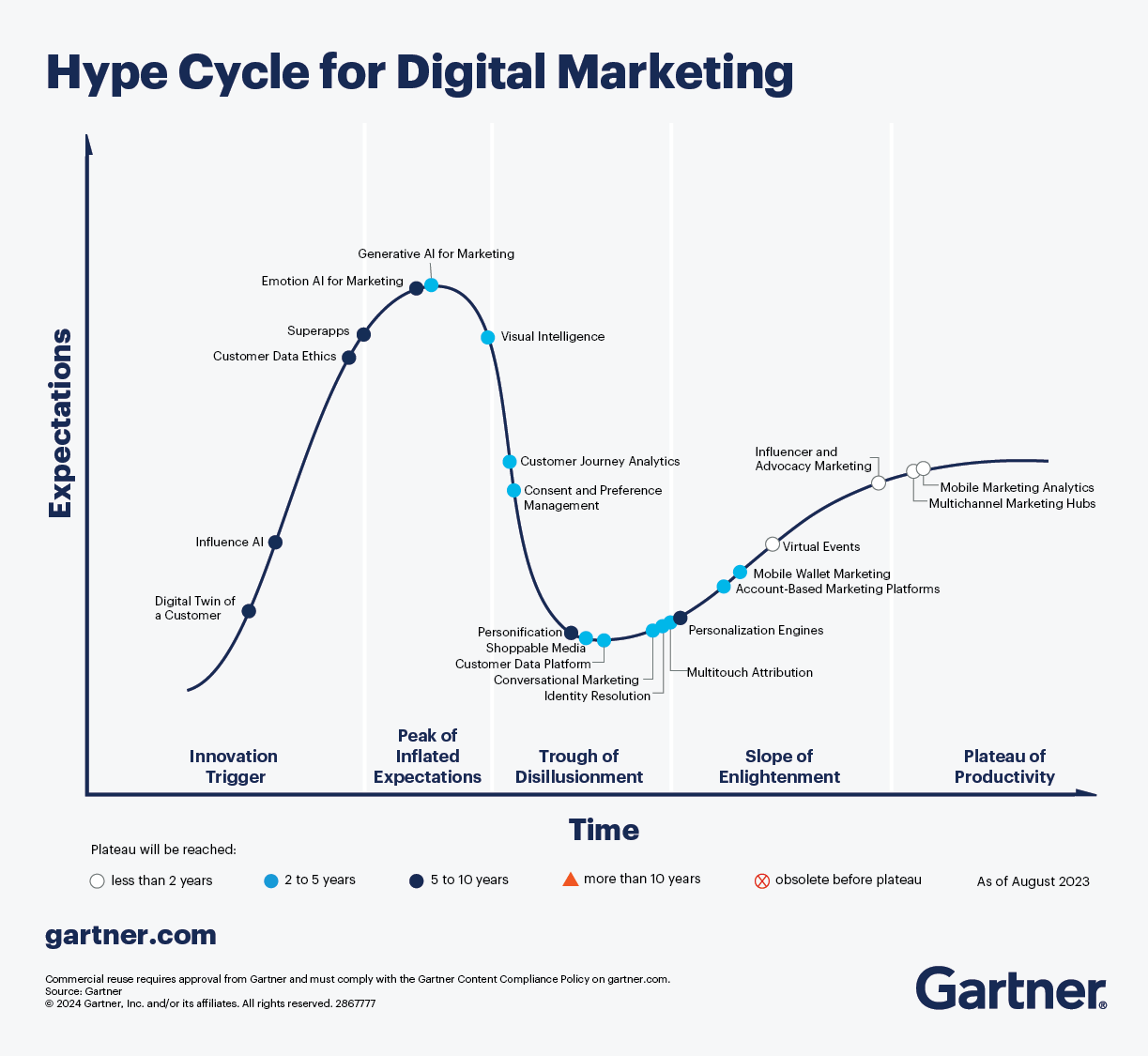 We have been sharing Gartner's digital marketing hype cycles for over 10 years now, since their structure provide an efficient structure for reviewing the latest technology. Their latest 2024 includes Digital Twins of the customer which we listened to several marketers mentioning their value at a recent workshop.
We have been sharing Gartner's digital marketing hype cycles for over 10 years now, since their structure provide an efficient structure for reviewing the latest technology. Their latest 2024 includes Digital Twins of the customer which we listened to several marketers mentioning their value at a recent workshop.
Using digital twins of the customer (DToC) allows you to create accurate, dynamic models of individual customers or segments, which can support personalized marketing. By leveraging these virtual profiles, you can:
1. Enhance Personalization - Use real-time insights from DToC models to tailor content, product recommendations, and engagement strategies based on predicted customer behavior.
2. Optimize Customer Journeys - Adjust campaigns and user flows dynamically, ensuring customers are guided toward products or services that fit their preferences.
3. Predict Needs and Trends - Run simulations to anticipate future customer needs, adjust to market trends, and proactively address pain points, making your brand more responsive and relevant.
Integrating DToC into your strategy helps in delivering value by predicting and meeting customer needs more accurately and building more engaging, data-informed campaigns.
Although IBM has been promoting its DTOC for its enterprise customers for several years now, there are new technologies emerging which are more accessible to other businesses.
For example, Pathmonk is on example of MarTech that uses AI based on Digital Twins.
You can see it it in action and results by visiting their customer stories page.
Unlike traditional personalization, which often relies on predefined rules or segments, Pathmonk’s AI-powered solution continuously learns from real-time visitor behavior. It dynamically adapts the content and experiences shown without needing manual input or updates. This means every interaction is based on the latest data, making personalization smarter, more relevant, and more effective at converting visitors.
Gartner's 2023 Emerging Technologies hype cycle, showed the importance of Generative AI (as exemplified by the popularity ChatGPT).
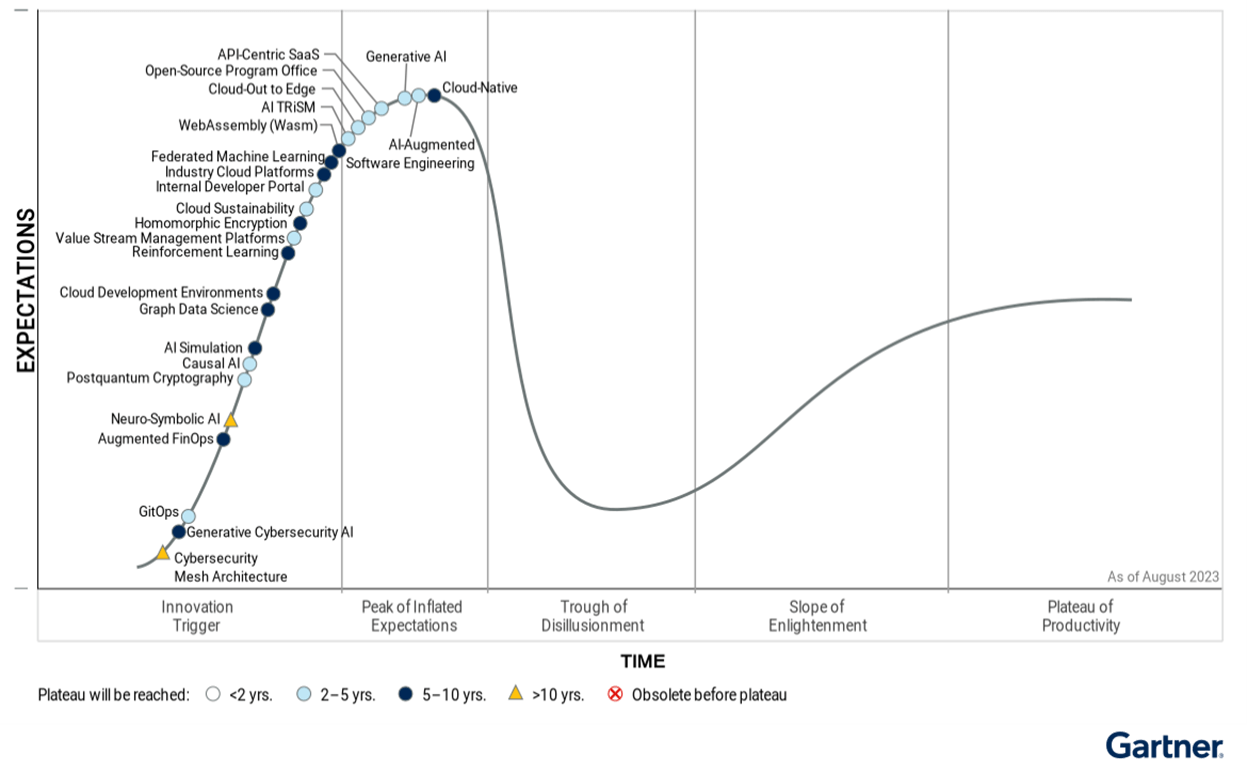
This takes the familiar form of a hype cycle from emerging technologies on the left through to more established technologies for which the plateau on the right will be reached and some point in the future with the forecasts shown by the colour within the circle. More detail explaining the hype cycle concept is given later in this article.
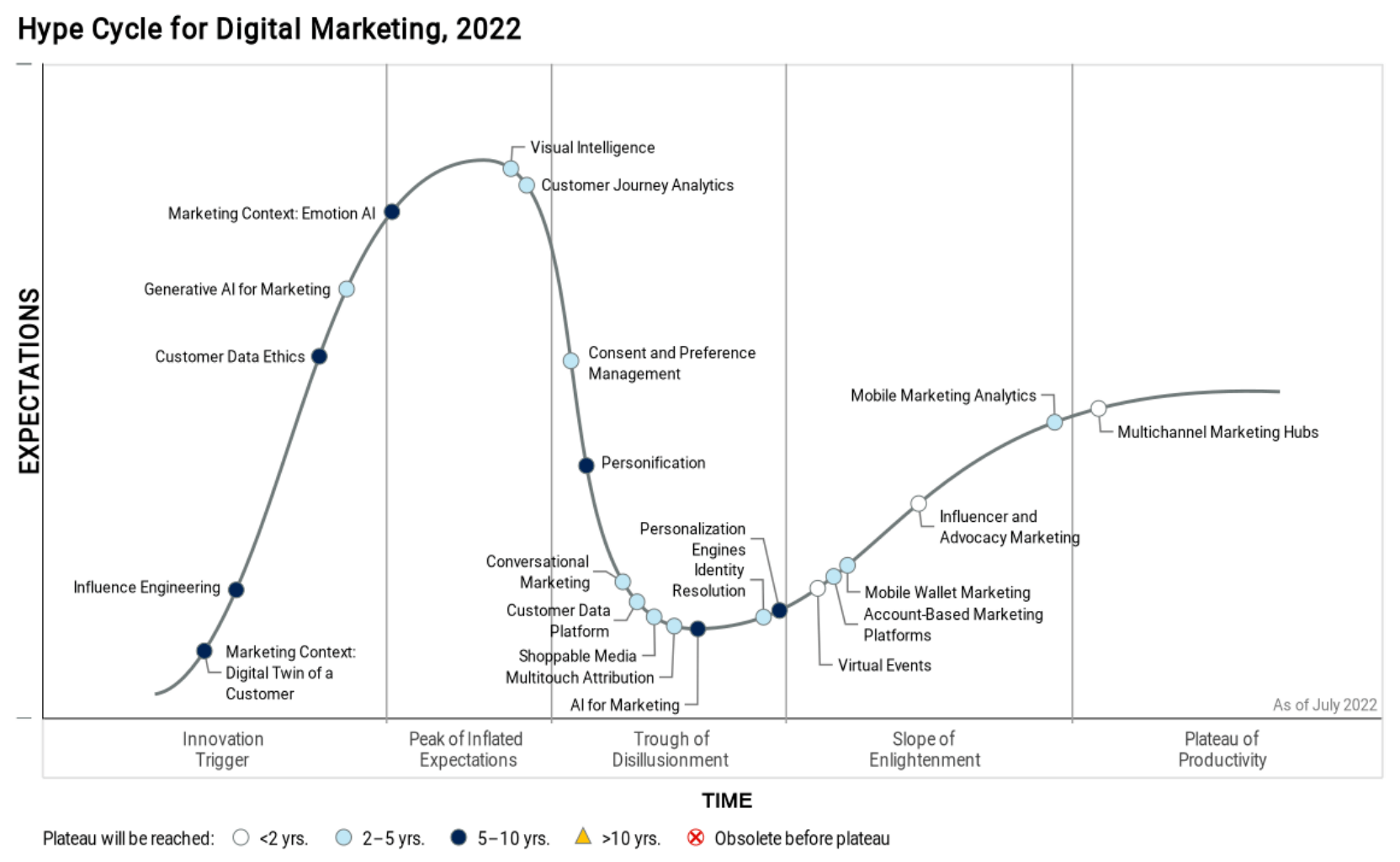
My analysis of the 2022 digital marketing hype cycle
For me, the main takeaways from the latest hype cycle are:
1. Digital twin of a customer (DToC) is an interesting new concept introduced by Gartner this year. They define the DToC as:
"A digital twin of a customer (DToC) is a dynamic virtual representation of a customer that simulates and learns to emulate and anticipate behavior. Customers can be individuals, personas, groups of people or machines. DToC gives marketers a flexible approach to anticipating a customer’s state of mind".
You can see this is a tool used for modeling the impact of changes to targeting and proposition before implementation. So it seems to be a form of predictive analytics based on AI. Although it's an interesting concept, it is likely to remain a niche application since most businesses will be more concerned with introducing or improving personalization to introduce improve conversion.
If you want to learn more, sample vendors are given as Absolutdata; Arrayworks; Fetch.ai; Salesforce and Tanjo.
2. Multichannel Marketing Hubs (clouds) of which email automation and personalization are part are now a core technology platform for many businesses and this is confirmed since these have already reached the plateau along with Conversational marketing which previously featured, but has now been removed since these are now part of the mainstream. It's likely you have these in place, the question is, what is the maturity of the implementation, how well are they customized to improve targeting and response? Which brings us to...
3. Tools to increase communications relevance through targeting. Tools to target such as Personalization engines and personification are now in the trough with personalization engines forecast to reach the plateau in 2-5 years. However, many would argue that in sectors such as retail, travel and financial services recommendations tools are already relevant.
4. Artificial Intelligence for marketing is in the 'trough of disillusionment'. This fits findings from our research on managing digital marketing amongst marketers which shows a relative lack of enthusiasm for adoption of AI and Machine Learning despite the number of vendors offering AI solutions. Our research also showed that many businesses are at a low-level of maturity in their digital marketing, with only the c10-20% of businesses who have the scale and skills to deploy AI currently using it. Surveying these larger organizations in 2021 Forrester found higher levels of adoption with 52% of marketers Gartner surveyed in 2021 using AI and ML, with another 38% in the planning or piloting stages with AI/ML. However, only 17% have deployed AI across all aspects of their marketing technology stacks. You can read more about the applications of AI in our infographic on 15 applications of AI for marketing.
5. Consumer consent and preference management technologies are often part of hubs/clouds/marketing automation, but are defined as a separate category by Gartner since they consider them a strategic investment with dedicated tools available for larger businesses.
6. Fewer new innovations than in previous years since the innovation trigger part of the marketing curve is sparse suggesting relatively few genuine new technologies are emerging. Indeed, I'm sure visual search has previously appeared here. It's not relevant to most businesses and I'm surprised that Augmented / Virtual Reality isn't highlighted on these curves since they are being adopted more widely. This suggests to me a maturity in tools has been reached and genuinely new techniques will be rare in future. This is suggested by our Digital marketing tools wheel (free download) which identifies 30 categories of technology.
To review which of the technologies are most relevant Gartner also share a visualisation to summarize the most relevant tools to consider as part of your marketing technology stack. The tools on the top left are most relevant here. For most small to mid-size organisations, those in the 'high benefit' row such as Hubs, ABM and Personalization are most relevant.
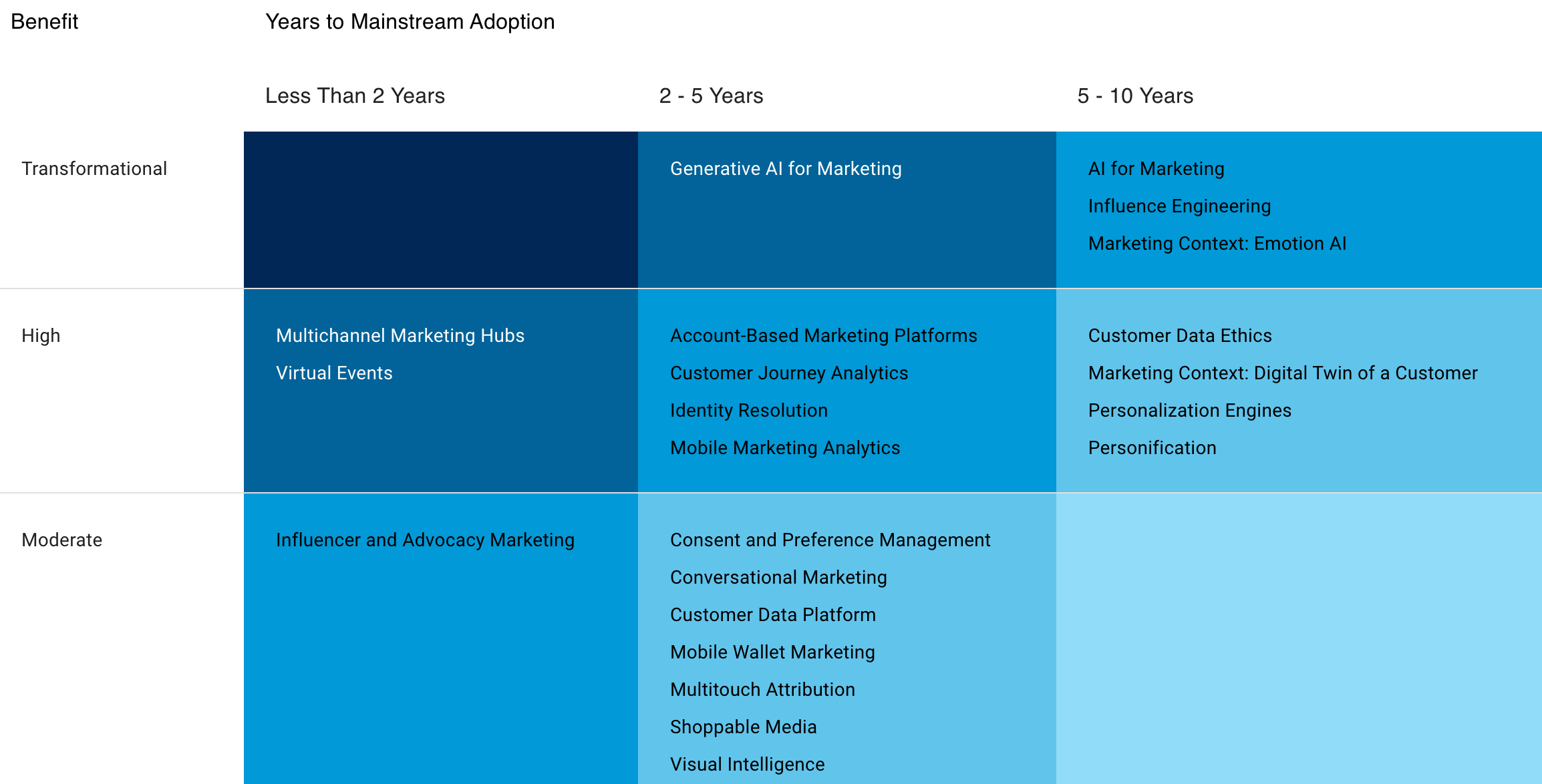
Understanding the stages of the Gartner Hype Cycle model for technology innovation
You may well be aware of the Gartner Technology Hype cycle concept since they have been published for over 10 years, but over time they have added a comprehensive range of hype cycles covering technology applications like e-commerce, CRM and ERP. Many of these are only available to subscribers, but Gartner does share some of the broader hype cycles through their blog/press releases and we share them here to raise awareness of these useful tools.
Here is the generic Gartner model of adoption of technology innovations showing adoption at different points in the product lifecycle.
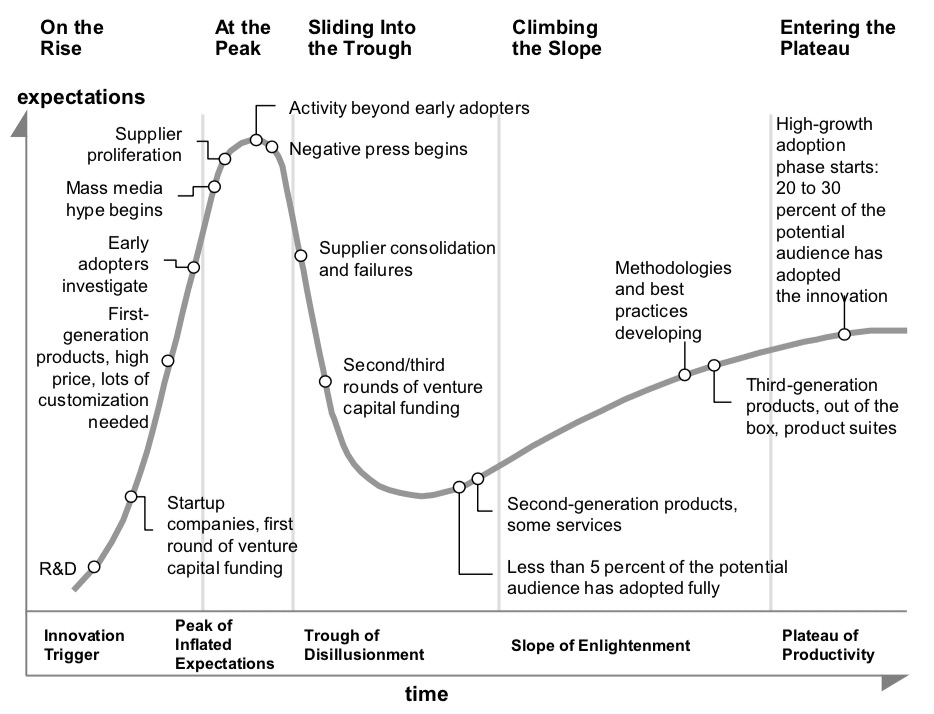
It raises interesting questions for when businesses should adopt new technology:
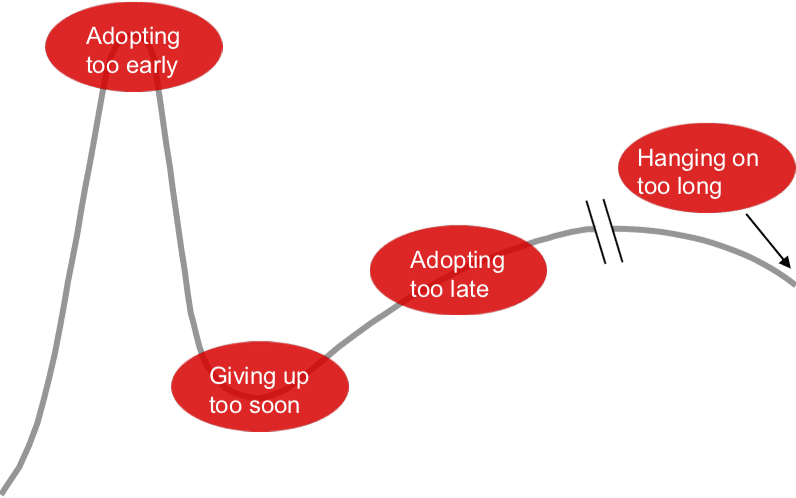
Many of the early deployment 'Innovation Trigger' techniques are less relevant for marketers compared to those related to AI which is now at the 'Peak of Inflated expectations'. One that caught my eye is Conversational User Interfaces. This is a useful application for marketers to consider since it includes using marketing chatbot examples, which we have featured on our blog this year. It also includes voice interactions through the likes of Apple Siri, Microsoft Cortana and Amazon Alexa/Echo.
Other technologies include marketing applications of machine learning which platforms like Google. Facebook, Amazon, IBM and Salesforce are deploying, with their mega budgets and research teams are working on integrating into their services. They include, for example, Augmented Reality, Cognitive Expert Advisors (described above as AI Chatbots), Smart Data discovery (of which Predictive Analytics is one approach) and IoT integration including the Connected Home.

For reference: comparing hype cycles through time
For those who are interested to review technology predictions against what actually happens in terms of popularity of deployment, here is a comparison for hype cycles from previous years that I have curated as I have updated this post. Note that some years Gartner only make the emerging technologies hype cycle available and not the marketing hype cycles.
2021 Digital marketing hype cycle
2021: The latest digital marketing Hype Cycle
For reference, this is the 2021 Digital Marketing Hype Cycle published by Gartner. If you're new to these Hype Cycles see the section later in this post explaining the stages of the Gartner Hype Cycle model for technology innovation.
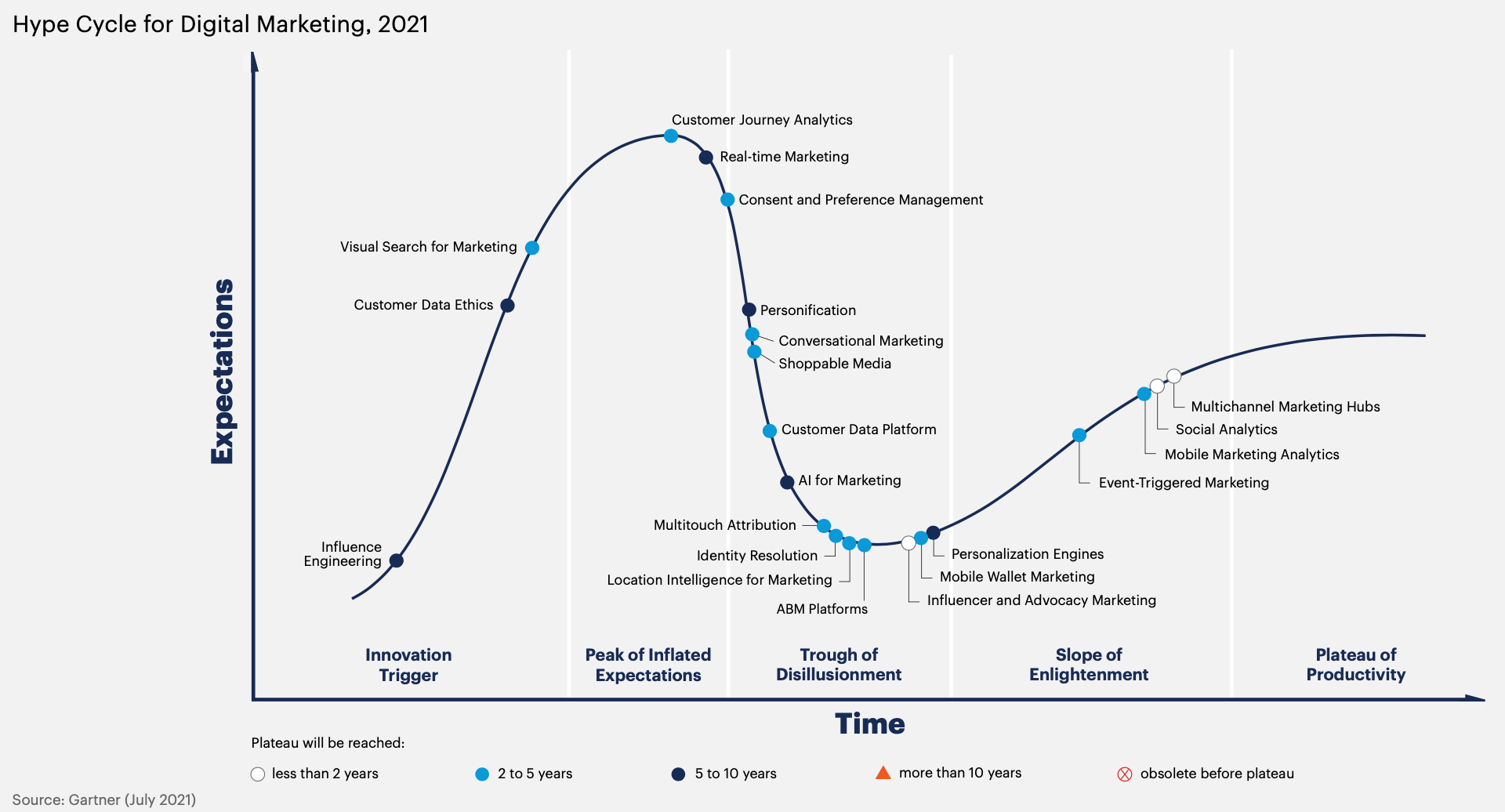
This matrix shows that despite the hype of AI for marketing, mainstream adoption is a long time into the future. For current investment cycles, it's more important to review pans within the next 5 years and in particular the next two years including integrated marketing hubs and influencer marketing.
2020 Digital marketing hype cycle
Here is the chart from Gartner of the 2020 digital marketing hype cycle.
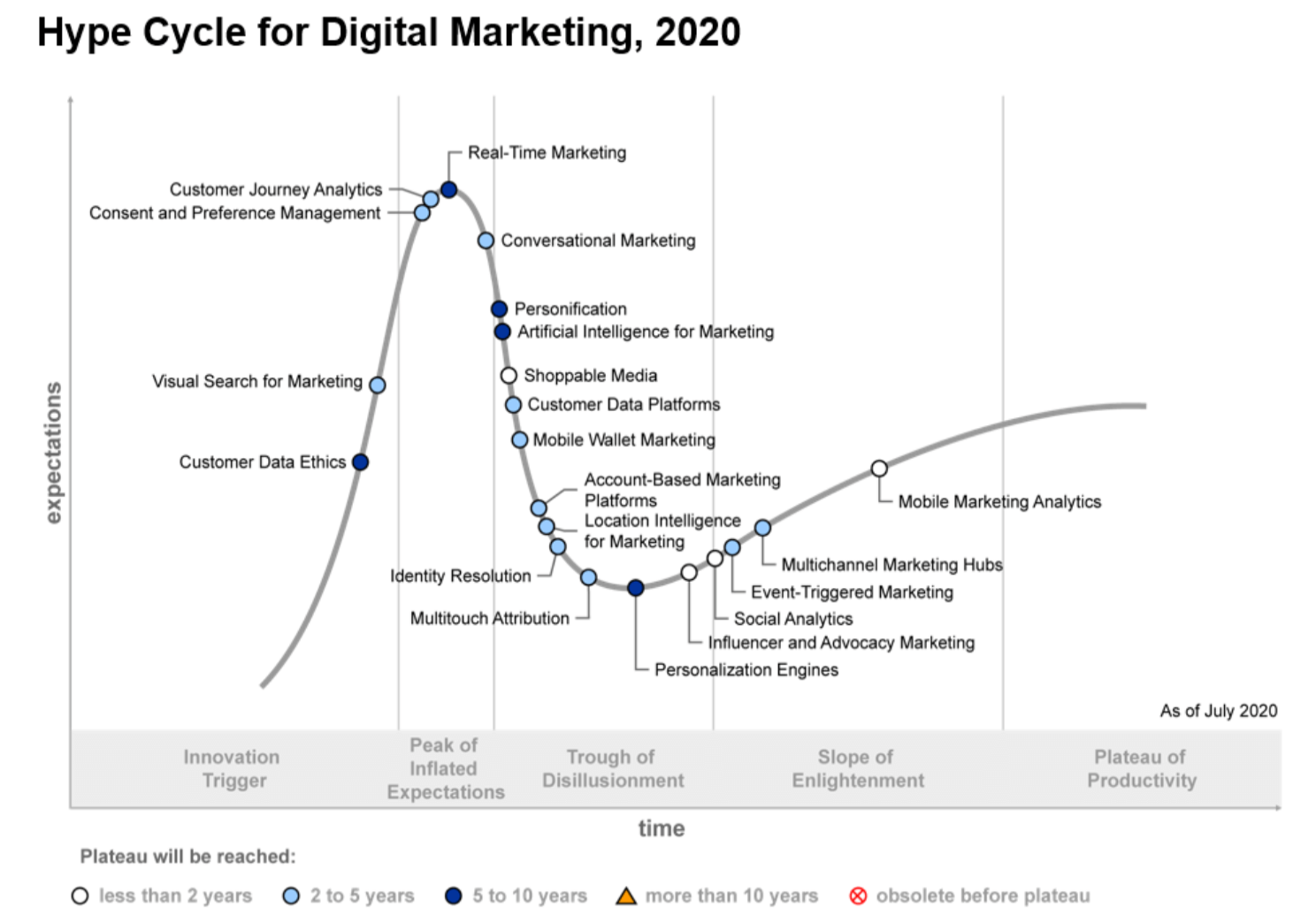 For comparison, this is the advertising hype cycle :
For comparison, this is the advertising hype cycle :
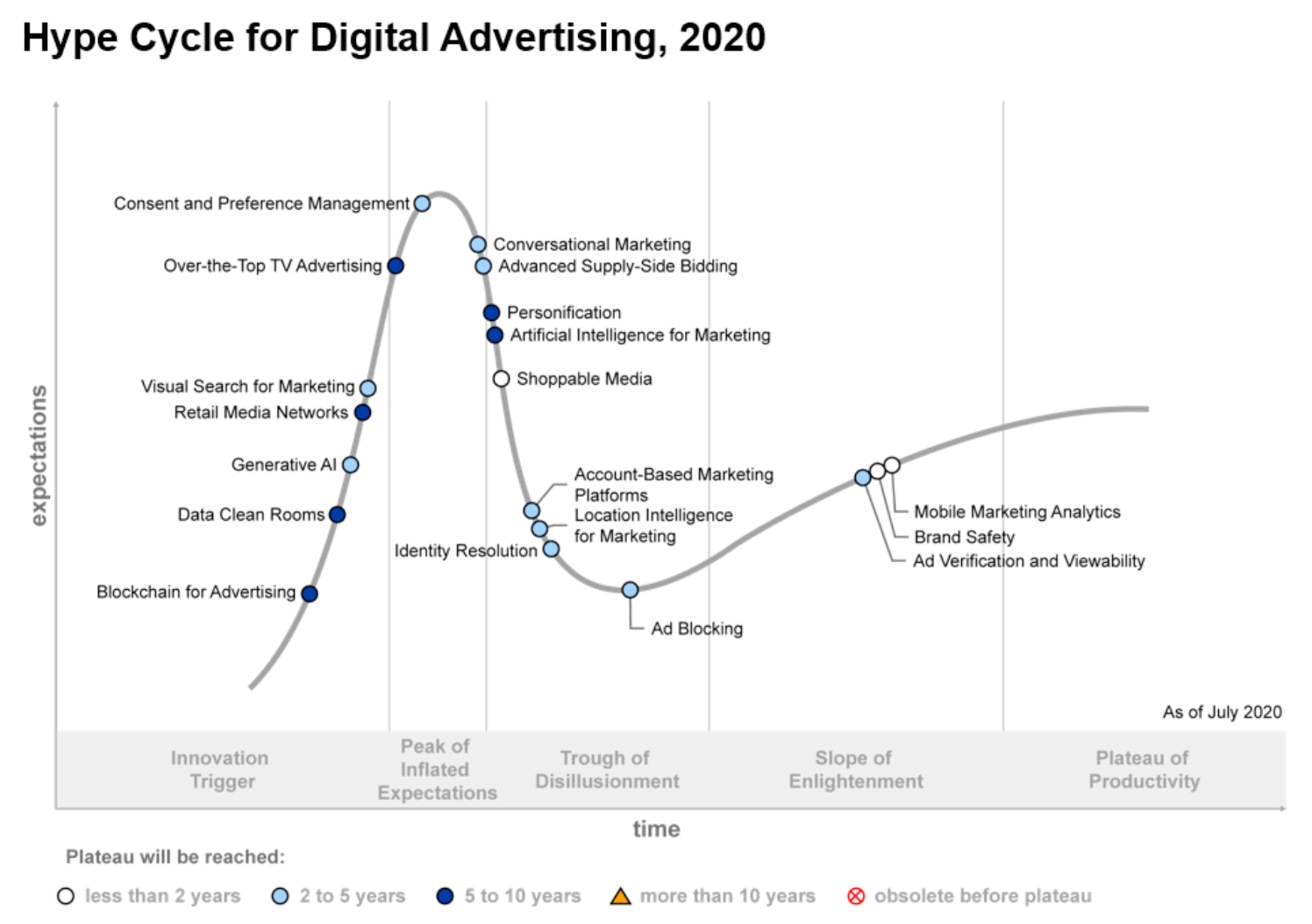
2019 digital marketing and advertising hype cycle
In August 2019 Gartner published their latest digital marketing and advertising Hype Cycle including their recommendations on 22 technologies marketers should focus on in the year ahead. Gartner's hype cycle for digital marketing is particularly useful for Smart Insights readers to consider their investments in marketing technology in the year(s) ahead.
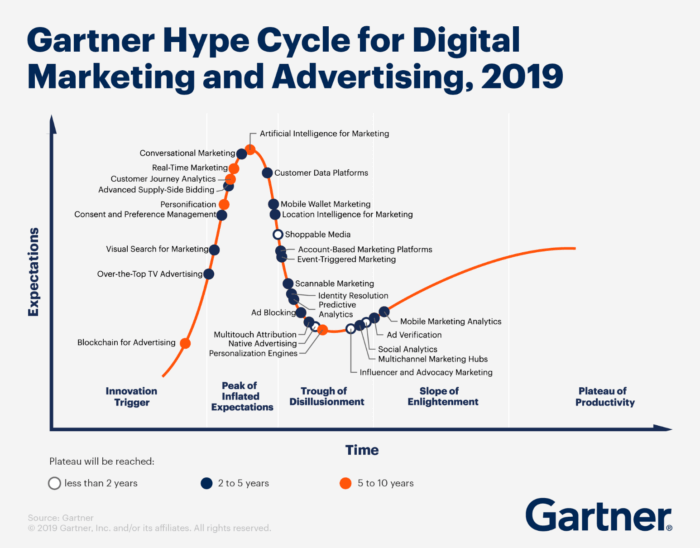
You can see that of the technologies on the Innovation Trigger slope, many aren't expected to become mainstream for 5 to 10 years. Of those forecast to hit the mainstream within the next 2 to 5 years, the three most significant for marketers to consider are personification, real-time and conversational marketing.
Real-time marketing covers a range of established techniques such as marketing automation and personalization in response to customer behaviour, e.g. consumption of media, content or responding to messaging. It's likely that you're already using this if your business has high digital maturity. I think what is new here is a more unified approach to managing relevance across the customer lifecycle using common platforms such as marketing clouds and Customer Data Platforms (CDPs) which also feature in the Gartner hype cycle.
In their article, the personification of digital marketing they define personification as:
"Enabling marketers to deliver targeted digital experiences to individuals based on their inferred membership in a characteristic customer segment rather than on their personal identity".
Personification in digital marketing has been promoted by Gartner since 1995 since as an approach where improved relevance can be delivered by providing segment-based communications. This is distinct from 1:1 communications based on an individuals' identity where permission hasn't been gained. You can see this is closely related to personalization.

The review also highlights the growing interest in Artificial Intelligence which in their opinion, "AI continues to seduce marketers". They say that unrelenting vendor hype shows no sign of slowing, yet AI hype in marketing heavily outweighs actual adoption.
They define the use of AI for marketing as follows and also highlight Conversational Marketing as a significant trend from their hype cycle.
- AI for marketing comprises systems that change behaviors without being explicitly programmed based on data collected, usage analysis and other observations for marketing use cases. Unprecedented insight, intuition and scale fueled by AI will help marketers deliver relevant experiences to prospects and customers with increasing effectiveness and efficiency.
- Conversational marketing technologies enable interactions between companies and customers that mimic human dialogue and do so at scale. This category is near the Peak of Inflated Expectations phase.
It's good to see the latter included since in previous years I commented that Conversational UI doesn't feature prominently. Conversational marketing is more commonly known as 'chatbots', but I think it's useful to generalize it, because it has wider implications for replacing other forms of communication such as Messaging Apps gradually replacing email marketing and the use of interactive live support on-site such as the Intercom service we use and similar services like Drift which are developing chatbots which can be used for B2B and B2C. Smart speaker use is also included within the category.
Other on-the-rise technologies on the 'Innovation Trigger' part of the hype cycle to consider for investment include:
- Blockchain for advertising
- Consent management (closely related to identity management)
- Visual search for marketing
- Real-Time Marketing [Personalization, not real-time PR]
- Personification
- Augmented and Virtual Reality marketing
- Header bidding (Programmatic) and Programmatic TV buying
- Customer journey analytics
- Conversational Marketing
- Multichannel marketing hubs
- Multichannel marketing hubs
Personally, I disagree that AR and VR are on the rise and I would place them as heading swiftly into the 'trough of disillusionment'.
Need a winning marketing strategy?
Book your free 1-2-1 consultation to develop your new strategy with the RACE Framework
Book consultation
2018 digital marketing hype cycle (Source)
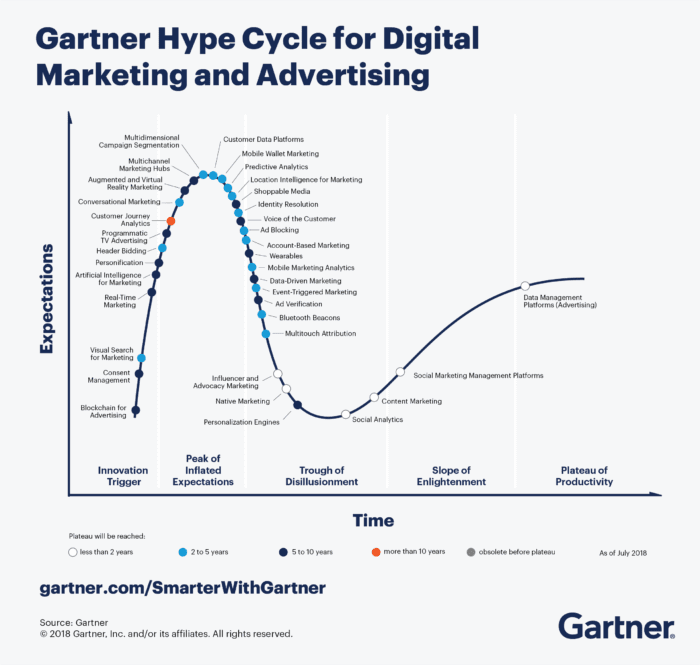
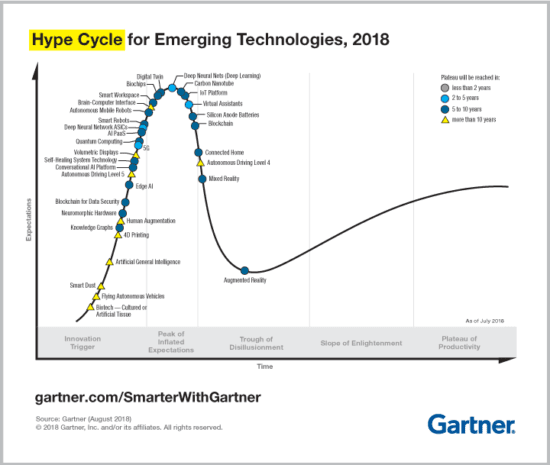
2017 emerging technologies hype cycle
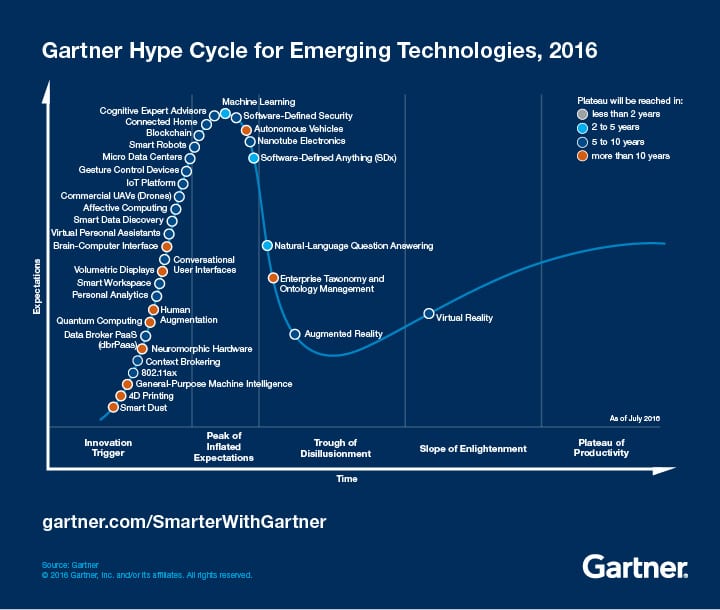
2016 emerging technologies hypecycle
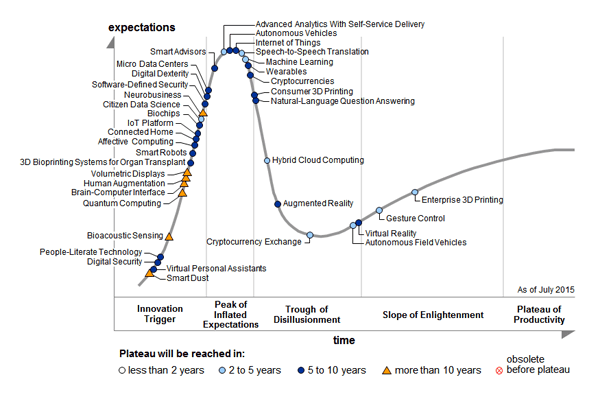
The Digital Marketing hype cycle for 2015
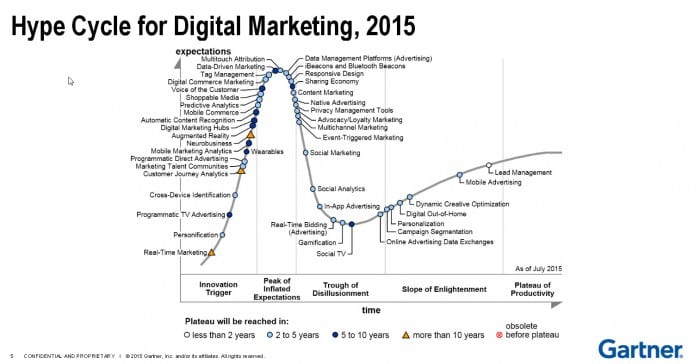
This report showcased some really interesting trends. Wearables are currently ascending the peak of inflated expectations, and with all the hype around them, they could have quite a long fall into the trough of disillusionment. Mobile advertising is now headed straight for the plateau of productivity, which is where it will rightfully sit given most web traffic now comes from mobile.
The 2015 Hype Cycle report identified 5 mega-trends that will play out over the next few years. These were:
- 1: Digital Business Moves Toward the Peak of Inflated Expectations
- 2: IoT, Mobility and Smart Machines Rapidly Approach the Peak
- 3: Digital Marketing and Digital Workplace Quickly Move Up
- 4: Analytics Are at the Peak
- 5: Big Data and Cloud Make Big Moves Toward the Trough of Disillusionment
Let's see how these compare to the 3 mega-trends predicted by 2014's report:
- Brain-Computer interface
- Virtual Reality
- Virtual Personal Assistants and Smart Advisors
Brain-computer interfaces still seem a while away for most of us, but there has been big strides in the interfaces, especially for controlling robotic limbs for people who have lost their legs or arms. VR was also a big trend of 2015, as was virtual personal assistants, with Facebook launching 'M' in beta, and Siri, Google now and Cortana all battling for market share.
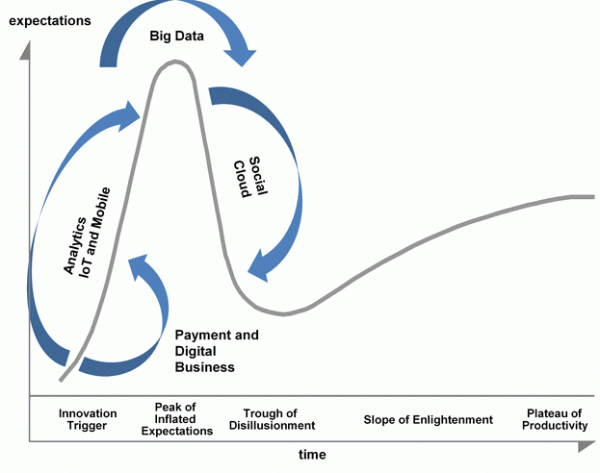
The Digital marketing Hype cycle for 2014
The emerging technologies trend report is the best known Gartner hype cycle but is in fact, one of many hype cycles covering activities from Big Data to e-commerce. Also, this year Gartner has released this report specifically on Digital Marketing which will be of particular interest to Smart Insights readers.
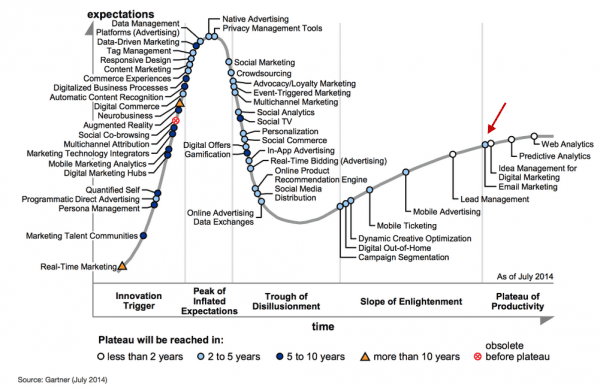
Gartner Hype Cycles for technology and marketing in 2013
For reference and comparison to previous years., we have included the Gartner technology maturity adoption curves from previous years. In July 2013 Gartner released their Digital Marketing Hype Cycle - you can see some interesting commentary in this Slideshare kindly recommended by Jon Clements in the comments to this post and we added this in December since it's sure to be of interest to Smart Insights readers. We cover many of these in our 2014 digital marketing trends post. Digital marketing specialists may be surprised to see some established techniques such as content marketing, attribution, responsive design and mobile analytics only at the innovation trigger stage although some of these are reaching the peak of the hype cycle.
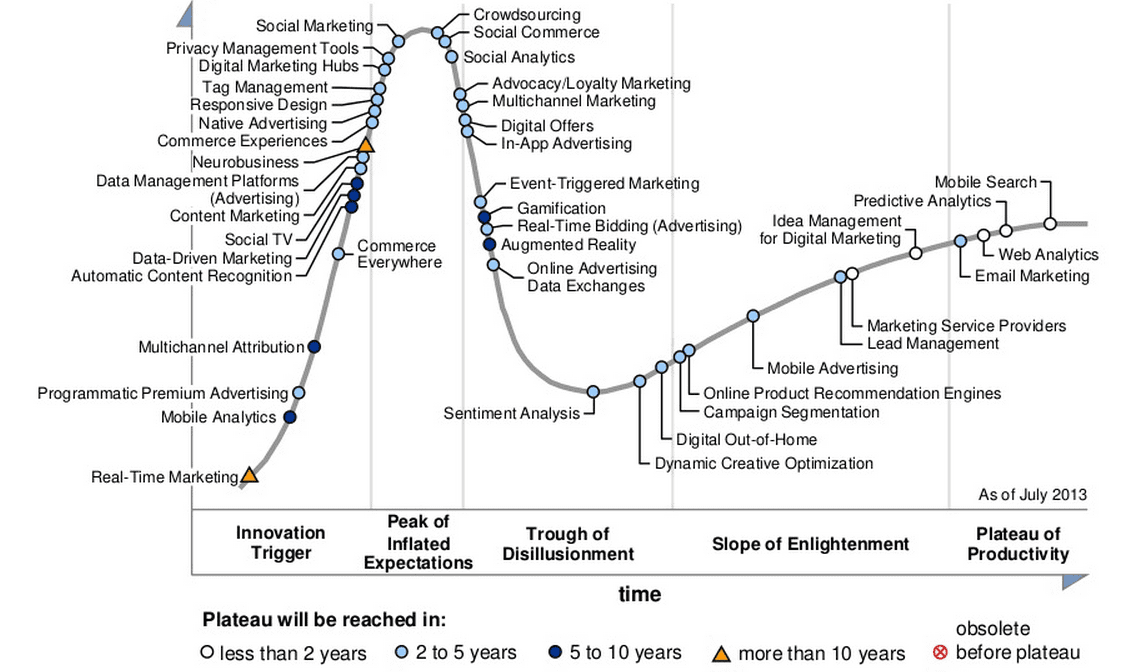
In August 2013, Gartner followed with its Latest 2013 Hype Cycle of emerging technologies. If you don't know it, this is one of the best ways to find out about the upcoming technologies which may affect digital marketing.
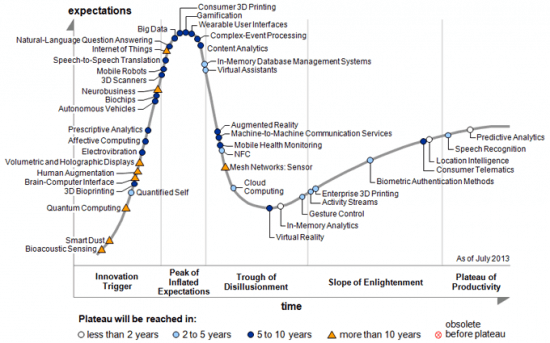
Marketers who follow new technology will not be surprised to see Big Data nearing the Peak of Inflated Expectations along with wearable technology. Scary-sounding new technologies to watch include the Brain-computer interface, Human Augmentation, and Neurobusiness.
For reference, we also have the 2010 and 2009 models from when I first wrote this post. It's interesting that those rising up the "peak of inflated expectations" currently those looking most relevant for marketing are Video search, Augmented Reality, IP TV are not mainstream still, probably consigned to the "Trough of Disillusionment".
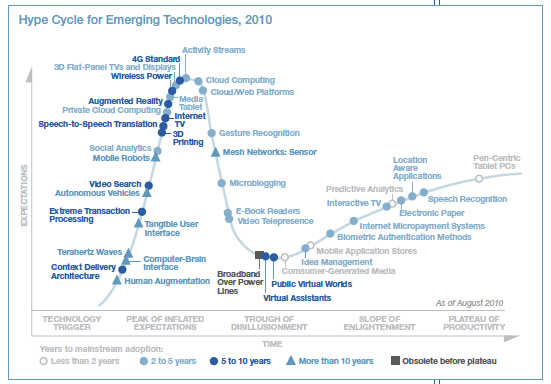
Gartner Hype Cycle 2009
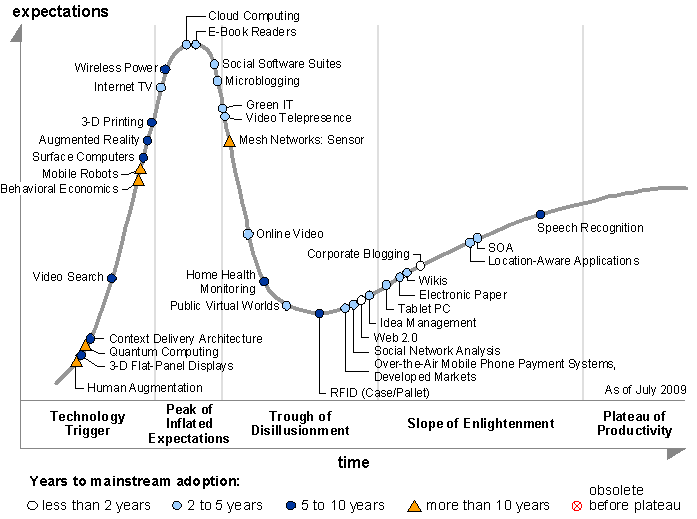
Here is my summary of the 5 stages of diffusion of innovation used by Gartner - it can be useful for explaining to colleagues your strategy when you have adopted a "wait and see" approach because you don't want to waste time implementing a solution that never gets out of the "trough of disillusionment". Alternately, in digital marketing, many smaller, nimble companies have gained an edge amongst early adopters of an approach such as social media or Web 2.0.
1 Technology Trigger - The first phase of a hype cycle is the "technology trigger" or breakthrough, product launch or other events that generates significant press and interest.
2 Peak of Inflated Expectations - In the next phase, a frenzy of publicity typically generates over-enthusiasm and unrealistic expectations. There may be some successful applications of technology, but there are typically more failures.
3 Trough of Disillusionment - Technologies enter the "trough of disillusionment" because they fail to meet expectations and quickly become unfashionable. Consequently, the press usually abandons the topic and the technology.
4 Slope of Enlightenment - Although the press may have stopped covering the technology, some businesses continue through the "slope of enlightenment" and experiment to understand the benefits and practical application of the technology.
5 Plateau of Productivity - A technology reaches the "plateau of productivity" as the benefits of it become widely demonstrated and accepted. The technology becomes increasingly stable and evolves in the second and third generations. The final height of the plateau varies according to whether the technology is broadly applicable or benefits only a niche market.
Selecting alternatives for marketing innovation
Selecting amongst hundreds of alternative projects is a challenge I commonly hear when talking to digital strategists. One approach I have developed when consulting, to help with this, is the matrix below which we describe along with other alternatives in our guide and template to justifying digital marketing investments. Of course, this structured approach won't fit the culture of all organizations, but even a simple unscored version of this is useful within a workshop to help discuss the relative merits of different digital projects.
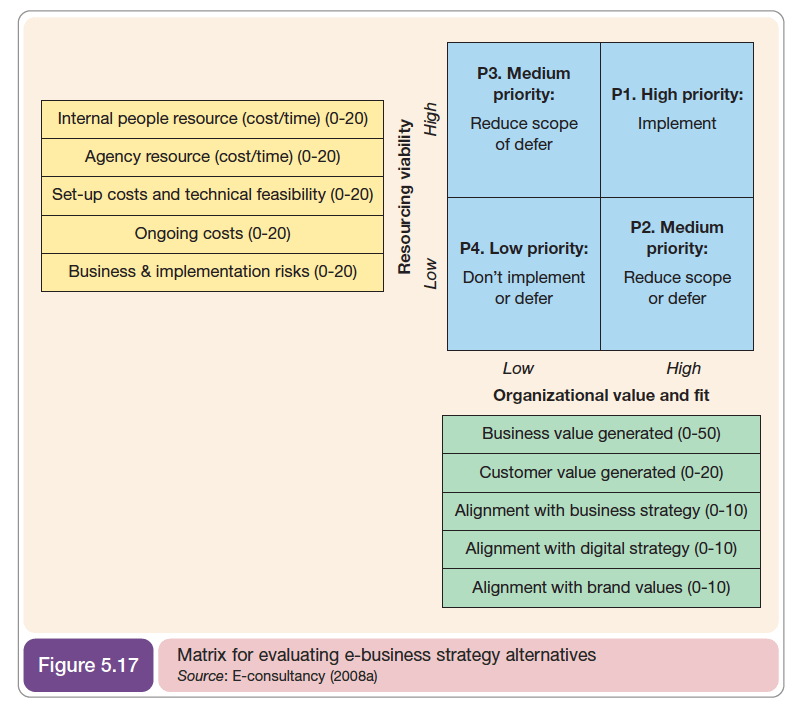
Need a winning marketing strategy?
Book your free 1-2-1 consultation to develop your new strategy with the RACE Framework
Book consultation



 We have been sharing Gartner's digital marketing hype cycles for over 10 years now, since their structure provide an efficient structure for reviewing the latest technology. Their latest 2024 includes Digital Twins of the customer which we listened to several marketers mentioning their value at a recent workshop.
We have been sharing Gartner's digital marketing hype cycles for over 10 years now, since their structure provide an efficient structure for reviewing the latest technology. Their latest 2024 includes Digital Twins of the customer which we listened to several marketers mentioning their value at a recent workshop.


























